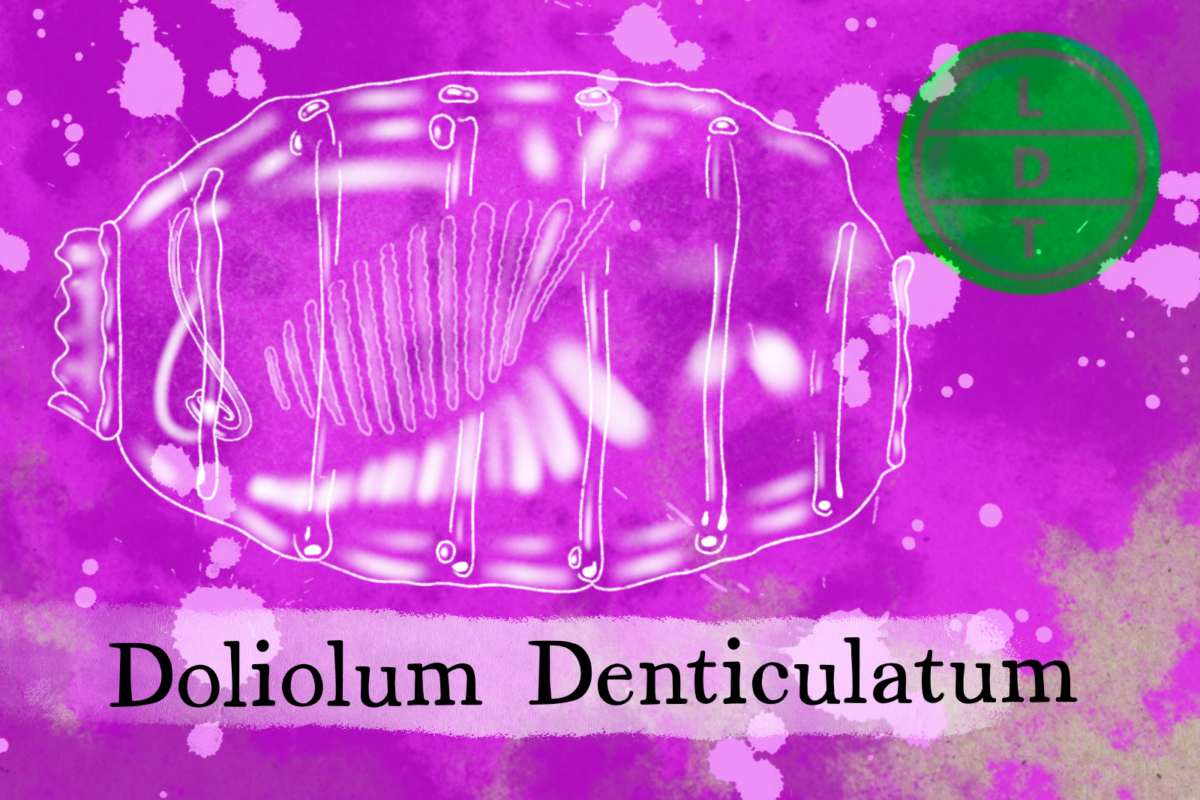“…and today we’re talking about a tiny barrel in the sea. But more on that later.”
Humans, like many animals, go through a familiar generational cycle. Your parents made you and their parents made them. But when you look closer, so close you can see the tiny things floating in the sea, things start to get much more complicated. What if your parents were sort of your siblings, and your grandma was your car? That’s what would happen if you were doliolida drifting through Life, Death, and Taxonomy.
Description of the Doliolida
- One of the least animal-like things we’ve covered, because it’s plankton
- Looks like a translucent cell with some organs floating around
- It’s shaped like a pillow or a barrel and is lined with eight bands down its body that act as muscles allowing it to expand and contract to eat and move
- It has a DNA helix-looking organ that functions as gills and you can see its stomach, nerves, and basic sensory organs through its skin.
Measure Up
Welcome to the beloved Measure Up segment. The official listener’s favorite part of the show! The part of the show when we present the animal’s size and dimension in relatable terms through a quiz that’s fun for the whole family. It’s also the part of the show that’s introduced by you when you send in audio of yourself saying, singing, or chittering the words Measure Up into ldtaxonomy at gmail dot com. We don’t have a new Measure Up intro.
Plankton 00:15
Length
- 1–2 mm long (I also saw up to 8 mm reported)
- How many Doliolida go into the barrel length of the M1903 Springfield Rifle?
- Hint: The rifle was developed by the U.S. for the Philippine–American War, but became standard issue in World War I for infantrymen.
- 305 doliolida. The barrel was 24 in (610 mm).
Living depth
- 100 m (328 feet)
- How many doliolida living depths go into the length of the Western Front?
- Hint: In WWI, the Western Front was a stretch of land through Belgium and France from the Swiss border to the North Sea.
- 6,439 depths. The front was over 400 miles.
Fast Facts about the Doliolida
- Range: Lives all over the tropics, which are the latitudes around the equator. But doliolida specimens have been found as far north as California.
- Diet: They are filter feeders that catch ocean detritus as they move around
- Behavior:
- They move through jet propulsion. Sucking in water from one end and shooting it out the other to move – kinda like a squid or Michael Phelps
- They can also move by having the little hairs on the inside of their bodies (scilia) move water through
- They are eaten by zooplankton and small crustaceans.
Major Fact: Mass Reproduction
Doliolids have both sexual and asexual generations. In other words, if you were a Doliolids, your grandparents might be your parents and your parents are you. The sexual generation are called gonozooids, which have eight muscle bands and male or female gonads, which are organs needed for sexual reproduction.
The female gonozooids lay eggs which are fertilized by the males. When the eggs hatch, the hatching looks slightly different with nine muscle bands and no gonads. They also have two stalks growing out of their dorsal and ventral sides (top and bottom respectively). The asexual generation are called nurses.
They reproduce by budding, which is when a piece of you grows and falls off to create a new individual. The buds are produced out of their ventral stalk. Here’s the weird part: they need to grow and develop on their dorsal stalk.
How? The buds transfer from one to the other while staying attached to the body by hitching a ride on special moving cells called phorocytes, which look like little amoebae.
As buds develop on the dorsal stalk, they develop their own dorsal stalk which they use to remain attached to the original. They develop spoon shaped bodies that are capable of filter feeding on their own. The stalk gets longer and longer with more and more spoon children. They are still asexual though.
Then, the phorocyte cells grow a second batch of buds. These are different from the first generation of buds. They are barrel shaped like the nurse and they attach to the nurse’s stalk by their ventral stalk instead of their dorsal stalk. This second generation of stalk children are called phorozooids. They are still asexual.
Meanwhile, we have a full on polymorphic colony going at this point, with a nurse on one end and a stalk of a bunch of buds coming off of it. Since the buds are doing a lot of feeding, the nurse loses its organs and mainly acts as the locomotive power for the colony.
Now, the stalk is full, so the phorocytes begin to plant more buds on the second generation ventral stalk, which is still attached to the colony. Finally, this third generation of buds planted between the second generation and the original stalk are sexual gonozooids.
When the second generation carrier phorozooids mature, they break off with their gonozooids buds. When all of the carriers leave the colony, the nurse and all of the asexual spoons die.
When the gonozooids reach maturity, they detach from the carriers and then the carriers die. The gonozooids lay eggs, fertilize them and repeat the process.
Three generations live and die, to produce a single generation that reproduces sexually. This process, starting with one individual, produces tens of thousands of Doliolida. Which is a growth rate unheard of among most animals.
Ending: So stand on the shoulders of giants, show love to the nurses in your life, and let the younger generations grow on you like the Dolioliotsenfrey here in LDT.

